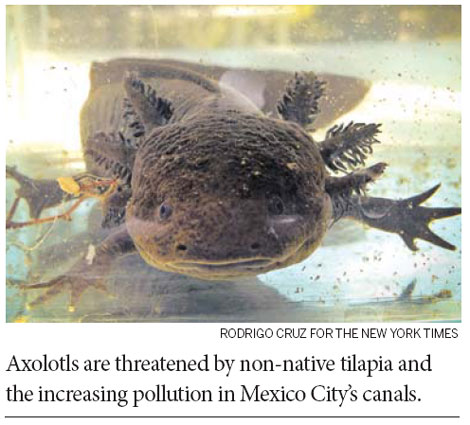Mythic salamander in a fight for survival
Updated: 2012-11-11 08:04
By Sofia Castello Y Tickell(The New York Times)
|
|||||||

MEXICO CITY - Aztec legend has it that the first axolotl, the feathery-gilled salamander that once swarmed through the ancient lakes of this city, was a god who changed form to elude sacrifice.
But what remains of its habitat today - a polluted network of canals choked with tilapia, a hungry fish imported from another continent - may prove to be an inescapable threat.
"They are about to go extinct," said Sandra Balderas Arias, a biologist at the National Autonomous University of Mexico.
The loss of this salamander in its habitat would extinguish one of the few natural links Mexicans have with the city that the Aztecs built on islands in a network of vast mountain lakes. Its extinction in the wild could also erase clues for scientists studying its mystifying traits.
Axolotls have long been bred successfully in aquariums, raised as exotic pets or as laboratory specimens for scientists investigating their extraordinary ability to regrow a severed limb or tail.
The Mexican axolotl has a flat head and spiked feet; it is unusual because it spends its entire life in the so-called larval stage, like a tadpole, without ever moving to land. "It grows and grows in the same shape, and has the capacity to reproduce," said the biologist Armando Tovar Garza.
Its gaze seems to captivate as its gills slowly beat. In Julio Cortazar's short story "Axolotl," the narrator is transfixed - "I stayed watching them for an hour and left, unable to think of anything else."
The Aztecs and their descendants consumed axolotls as part of their diet, and the amphibians are still stirred into a syrup as a remedy for respiratory ailments.
But in their only home, the canals of Xochimilco in the far south of the city, the axolotls' decline has been precipitous. For every 60 of them in 1998, researchers could find only one a decade later, according to Luis Zambrano, another biologist at the National Autonomous University of Mexico.
In the canals where the Aztecs once farmed floating gardens, cinder block houses now dump their waste, students toss their beer cans during parties and the water quality keeps worsening. Tilapia were introduced over 20 years ago, in an effort to support fishermen. But the fish have reproduced faster than they can be caught, and they feed voraciously on the plants where the axolotls lay their eggs.
Dr. Zambrano is creating a series of small tilapia-free sanctuaries by blocking off the entrances to certain canals. After placing trackers on test axolotls, his team was surprised to see how lively they were in the wild. "In the lab, they become really still, and here they are very active," Mr. Tovar said. "They're more awake." The axolotls have also been growing faster in the sequestered canals.
Another team of researchers has begun testing for a new home far from Xochimilco, in an artificial lake in Tecamac, about an hour outside Mexico City.
Ms. Balderas and her student assistant, Marlen Montes Ruiz, are monitoring laboratory-bred axolotls to see if they are capable of hunting water bugs and other prey and coping in the wild after being pandered to for so long.
So far, they say, axolotls have adapted well and have even become adept at hiding from the researchers, just as the ancient god eluded his captors.
The New York Times
(China Daily 11/11/2012 page11)